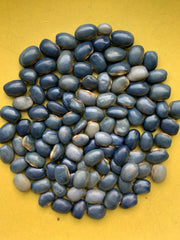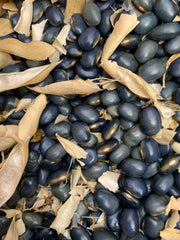Bean, Pole Dry, 'San Bernardo Blue'
(P. vulgaris) We consider ourselves true connoisseurs when it comes to appreciating the beauty of dry beans, and I have to say, I have never been quite so mesmerized by a bean as I was cracking open pods of San Bernardo Blue the first summer we grew it. Originally collected in a village of the same name in Northern Italy, our stock seed came to us from our friends at the Experimental Farm Network. Tall, vigorous, and productive climbing vines hang heavy with pods. The stunning blue color of the seed coat is unlike any we've seen and is apparently sensitive to the temperature it matures at: slate blue-grey in hotter temperatures and rich deep cobalt in our cooler PNW harvest time. Like all beans, the color changes over time in storage as the pigments oxidize. While on the later side of maturity for our far northern location, we haven't had any trouble successfully harvesting them at our home farm.
Sometimes known elsewhere as "Nonna Agnes blue bean" we, along with EFN, collectively decided to rename it from the arbitrary name given (it has no real connection to anyone by that name) to one that reflects its place of origin.
110 days. UO
Packet: 15 beans
Availability: In stock
Growing Info
SOWING:
Direct seed after the last frost date when the soil has warmed.
Note: Beans prefer well-drained, warm soil.
PLANTING DEPTH:
1"
SPACING:
3-5" between plants with 12-24" between rows*
*Pole beans require 5+' between rows.
EMERGENCE:
5-10 days @ soil temp 65-90F
LIGHT:
Full sun to part shade
FERTILITY:
Light to Moderate. Beans can produce their own usable nitrogen from atmospheric nitrogen through a symbiotic relationship with bacteria that colonize specialized nodules in their roots. Too much soil fertility can cause excessive vegetative growth at the expense of pod set and maturity.
Beans prefer well-drained, warm soil with a pH between 6.0-7.0.
ADDITIONAL NOTES:
Beans prefer warm soils and may rot at lower temperatures. This is particularly true for white-seeded varieties. You love beans. Patience.
It can be quite beneficial to mix bean seeds with commercially available bacterial "inoculants" to encourage the beneficial symbiotic relationship in the growing plant's root nodules, especially if growing on ground that hasn't been planted with beans before. This can increase yields and improve plant health.
Avoid picking/weeding beans when the plants are wet. This will help prevent the spread of disease.
Provide a trellis for pole beans.
White-seeded varieties are more susceptible to rot when seeded in cool, wet, early-season conditions.
Sow Snap Beans every few weeks for continued harvests.
Harvest dry beans when the pods are brown and dry.




